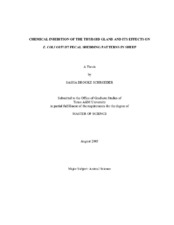| dc.description.abstract | Due to the seasonal nature of E. coli O157:H7 shedding and of hormone
production by the thyroid gland, two studies were initiated to determine whether
chemical inhibition of the thyroid gland influences fecal shedding of Escherichia coli
O157:H7. Twenty-four crossbred sheep (68.6 kg BW) were randomly assigned to pen
and either 0.0 mg/kg BW PTU or 20 mg/kg BW PTU for 5, 11, or 14 days. Sheep were
experimentally infected (d 0) with E. coli O157:H7 11 days prior to PTU treatment.
Fecal and serum samples were collected for bacterial enumeration and for analysis of T3
and T4, respectively. Sheep were humanely euthanized and tissue and content samples
were collected from the rumen, ileum, colon and rectum. Detection of E. coli O157:H7
increased toward the terminal end of the GI tract. In the treatment group, serum T3
levels decreased to an overall lower level than the control group. A correlation was seen
between T3 levels and daily O157:H7 bacterial shedding (P=0.003; r=0.37). In
experiment 2, 12 growing lambs (41.04 kg BW) were exposed to either 0.0 mg/kg BW
PTU or 40 mg/kg BW PTU for 21 days. Fecal samples were collected for analysis of
generic E. coli and body weights were recorded on days 0, 7, 14, and 21. Feed intake
was recorded throughout the experiment. Animals were experimentally infected with E.
coli O157:H7 on day 15. Sheep were humanely euthanized on day 21 and GI tract tissue and content was collected from the rumen, ilium, colon and rectum. A date by treatment
interaction was observed for T4 (P=0.0016) and hormone levels decreased in treated
animals. Thyroxine and E. coli O157:H7 display a multivariate treatment (P=0.0005)
and date effect (P=0.0174) but no significant interaction. Triiodothyronine and E. coli
O157:H7 shedding have a slight date trend (P=0.065) but no significant treatment or
treatment by date interaction. Generally, the treatment group shed genreric E. coli at
higher levels throughout the study period with slightly more than a log count difference
between groups at the last collection point (control = 3.8 CFU/gram of feces (log10);
treatment = 4.9 CFU/gram of feces (log10)). Results from these experiments suggest that
correlations exist between both E. coli O157:H7 and generic E. coli shedding in sheep. | en |


